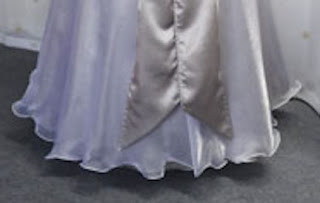GENERAL GUIDES FOR PINNING LENGTH
- assuming the length is initially level
1. Providing the overall length is straight & even (to begin shortening), all that is necessary is one pin (at back & front) to hold the fabric in position at both these places.
2. If the special event (eg. wedding ceremony) is to be worn on both soft (eg. grass) & hard (eg. stone) surfaces, the skirt length should ideally be in the best average position for both although sometimes, one surface may be the governing factor. For example, a shorter length would be best for a wedding held on grass all day where only a walk across paving for photos would take place once.
3. If there are other people in a ‘group’ (ie. bridesmaids especially if similar ages), all dresses should be identical &/or similar lengths. This is most noticeably visible after the event when seen in photos!
4. Ensure underwear garment is tried on with the correct underwear & shoes. Both of these items can have a knock-on effect on ultimate length.
5. Stand straight, with arms down by sides.
6. It is often a good idea to get someone to take photos of the dress - often the correct &/or better length can be more clearly visible by this method.
7. Ensure safety pins are not heavyweight ones & select their suitability for fabric type.
Adjusting length
1. Tuck lining (if there is one) underneath the skirt - if necessary roughly pin it up to ensure it is not in the way of the top layer of fabric as it hangs down & over it.
2. Fold under (or if easier, fold up) the dress hem to the desired length & hold in place with additonal pins to determine correct length.
3. For an average full skirt & long floor length: on a hard surface, toes/shoe tips should just be visible below the hem; on a soft surface, a partial instep should be visible (ie. as the shoes 'sink into' the soft surface, the skirt becomes longer). As a guide, it may be a difference of between 1cm (standing on a hard surface) & 3cm (standing on a soft one) although an element of preference will be of importance especially if there are other people in a group (eg. other bridesmaids) to be considered. For a very full skirt: the suggested length differences as above will basically apply but depending on the fabric type & hem finish, this can vary considerably. For instance (a) a rolled hem (see image above) will appear to be shorter (because it ‘flutes upwards’) in contrast to a flat hem (b) a skirt with netting underneath will appear to be longer & the netting will in many instances “get in the way” of any body movement. For a straight &/or less full skirt: the main criteria here is one predominantly of ‘looks’. If only a minimal amount of shortening is required, use the guide for average full skirt. However, if a much larger amount needs to be reduced, it may effect the ultimate style of the skirt/dress & the manner in which the proportions change. For instance, a lower frill that is a third of the skirts’ length, if considerably shortened, will effect the entire overall style of the dress & in many instances will become unflattering to the wearer & a better option may be to (a) increase shoe height (b) remove the frill & replace it at a higher level (c) choose a different style of garment.
4. Safety should also be a factor in deciding length. For instance, if new & very high heels are to be worn, it would be better to have a shorter length skirt than a longer one but if (for example) other bridesmaids dresses were longer, then a lower heel should be considered as a better option to obtain the longer length skirt, as per the same length as the others.
4. In respect of hard/soft surfaces, these are easily replicated around the house by flooring types eg. wood v. carpet.
5. Once a length is decided (if necessary adding further pins), walk &/or ’twirl’ around to verify how the skirt length moves. Does it become just a bit too long if dancing? - Is it too short & has become unflattering?








